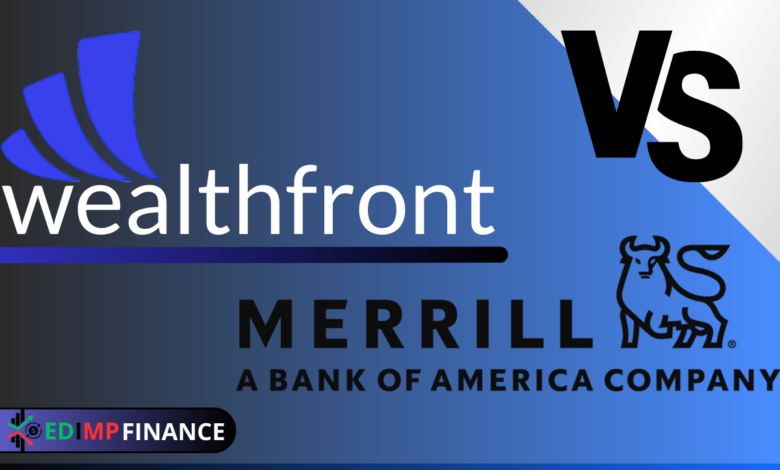Wealthfront vs. Merrill Guided Investing: Which Should You Choose?
Compare two of the top robo-advisors to help manage your portfolio

Table of Content:
| Heading | Subheading |
|---|---|
| I. Introduction | - Brief overview of robo-advisors |
| II. Account Setup | - Wealthfront account setup process |
| III. Account Types | - Different account types offered by Wealthfront and Merrill Guided Investing |
| IV. Account Services | - Services provided by both platforms |
| V. Goal Planning | - Goal planning tools and approaches of Wealthfront and Merrill Guided Investing |
| VI. Portfolio Construction | - Construction of investment portfolios by both platforms |
| VII. Portfolio Customization | - Flexibility in customizing portfolios |
| VIII. Portfolio Management | - Management styles and strategies employed by Wealthfront and Merrill Guided Investing |
| IX. Tax-Advantaged Investing | - Tax-related features and strategies |
| X. Security | - Security measures implemented by Wealthfront and Merrill Guided Investing |
| XI. User Experience | - Desktop and mobile experiences |
| XII. Customer Service | - Support services provided by both platforms |
| XIII. Fees | - Fee structures and associated costs |
| XIV. Final Verdict | - Summarizing the comparison and highlighting key factors |
I. Introduction
Robo-advisors have revolutionized the way individuals manage their portfolios. In this comparison, we delve into two prominent players: Wealthfront and Merrill Guided Investing. Each has its unique strengths and features, catering to different investor preferences.
II. Account Setup
Wealthfront streamlines the account setup process with a user-friendly approach. From creating a username to choosing the investment account type, users experience a straightforward onboarding process. On the other hand, Merrill Guided Investing offers a guest login option, simplifying the initial steps for potential investors.
III. Account Types
Wealthfront provides a diverse range of account types, including individual and joint taxable accounts, IRAs, 529 plans, and more. Merrill Guided Investing offers a variety of accounts as well, ensuring flexibility to meet different investment needs.
IV. Account Services
Wealthfront stands out with additional services like a high-yield cash management account, cash access through a debit card, and the option to borrow against the investment balance. Merrill Guided Investing focuses primarily on robo-advisor services but allows access to broader banking and brokerage services through Merrill and Bank of America.
V. Goal Planning
Both platforms prioritize goal planning, assisting users in defining and reaching their financial objectives. Wealthfront employs an automated planning tool called Path, while Merrill Guided Investing categorizes goals to tailor investment mixes.
VI. Portfolio Construction
Wealthfront constructs portfolios using low-cost ETFs, offering diverse investment styles such as socially responsible and direct indexing. Merrill Guided Investing, overseen by human advisors, aims to outperform the market with a portfolio mix of stock funds, bond funds, and cash.
VII. Portfolio Customization
Wealthfront provides extensive customization options, allowing users to adjust risk tolerance, choose specific ETFs, and design personalized portfolios. Merrill Guided Investing, while offering flexibility in goal selection, limits manual adjustments, emphasizing expert-guided portfolio management.
VIII. Portfolio Management
Wealthfront employs a standard robo-advisor approach, focusing on maintaining target allocations through automated rebalancing. Merrill Guided Investing, with human advisors overseeing, actively adjusts portfolios based on market conditions, providing a dynamic investment strategy.
IX. Tax-Advantaged Investing
Wealthfront gains an edge in tax-advantaged investing with automatic tax-loss harvesting, optimizing returns while minimizing tax liabilities. Merrill Guided Investing, lacking this feature, relies on its expert-guided approach to seek higher returns.
X. Security
Both platforms prioritize security, implementing top-tier measures like two-factor authentication and SSL encryption. Wealthfront adds FDIC insurance through its cash management account, while Merrill Guided Investing relies on Bank of America for FDIC coverage.
XI. User Experience
Desktop and mobile experiences on both platforms are commendable. Wealthfront offers robust investment tools, while Merrill Guided Investing ensures a clean and simple interface, enhancing accessibility.
XII. Customer Service
Merrill Guided Investing excels in customer service, providing 24/7 phone support, live chat, and premium account options for scheduled meetings with human advisors. Wealthfront emphasizes self-service with phone support available but less prominently featured.
XIII. Fees
Wealthfront charges a 0.25% annual AUM fee, offering a cost-effective solution. Merrill Guided Investing is relatively pricier, with a 0.45% fee for the robo-advisor and an 0.85% fee for access to human advisors.
XIV. Final Verdict
Choosing between Wealthfront and Merrill Guided Investing depends on individual preferences. Wealthfront, with its cost-effectiveness, customization options, and tax-loss harvesting, suits self-directed investors. Merrill Guided Investing, with its hybrid model and expert guidance, appeals to those seeking a more hands-on approach with higher fees.




